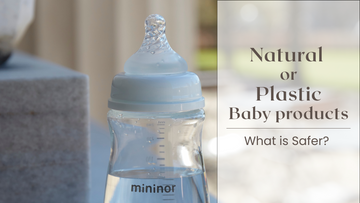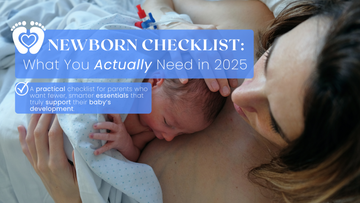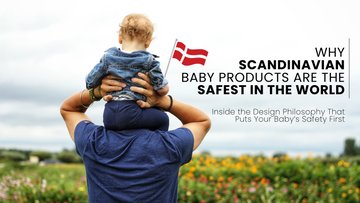When you're choosing products for your baby, the endless debates about materials can feel overwhelming. One aisle promises "all-natural" solutions while another showcases "BPA-free plastic" innovations. As parents, we want to make the safest choices, but conflicting information makes this decision surprisingly complex.
The truth is, both natural and plastic baby products can be safe when properly manufactured and used correctly. The key lies in understanding what to look for in each category.
Understanding "Natural" Baby Products
The term "natural" in baby products typically refers to materials derived from plants, minerals, or other non-synthetic sources. Common examples include:
- Organic cotton for clothing and textiles
- Bamboo fiber for bottles and utensils
- Wood for toys and feeding accessories
- Natural rubber for pacifiers and teething toys
- Glass for bottles and food storage
However, "natural" doesn't automatically mean safer. Poison ivy is natural, but you wouldn't want it near your baby. The safety of natural products depends on processing methods, quality control, and proper manufacturing standards.
Advantages of Natural Materials:
- Often biodegradable and environmentally friendly
- Generally free from synthetic chemicals
- Can be gentler on sensitive skin
- Many parents feel more comfortable with familiar materials
Potential Concerns:
- Natural materials can harbor bacteria if not properly treated
- Some natural substances can cause allergic reactions
- Quality can vary significantly between manufacturers
- May not always be as durable as synthetic alternatives
The Reality About Plastic Baby Products
Modern plastic baby products have evolved significantly from earlier generations. Today's baby-safe plastics are rigorously tested and regulated, with many offering advantages that natural materials simply can't match.
High-Quality Plastic Advantages:
- Durability: Resistant to breaking, which reduces choking hazards
- Easy sterilization: Can withstand high-temperature cleaning
- Lightweight: Easier for babies to handle independently
- Design flexibility: Allows for innovative safety features
- Cost-effective: Often more affordable than natural alternatives
What to Look For:
- BPA-free certification (Bisphenol A has been linked to health concerns)
- Phthalate-free materials (some phthalates may disrupt hormones)
- Food-grade ratings for items that contact food or go in mouths
- Compliance with EU and FDA safety standards
Safety Standards: The Great Equalizer
Regardless of material, reputable baby products must meet strict safety standards. In Europe, look for:
- CE marking indicating European Conformity
- EN 71 compliance for toy safety
- Oeko-Tex certification for textiles
- LFGB approval for food contact materials
These standards apply equally to natural and plastic products, ensuring both undergo rigorous safety testing.
When Natural Makes Sense
Choose natural materials when:
- Your baby has sensitive skin or known allergies to synthetic materials
- You prioritize environmental sustainability
- The product will have prolonged skin contact (like clothing or bedding)
- You prefer the aesthetic and feel of natural materials
Examples: Organic cotton muslin cloths, wooden teething toys, natural rubber pacifiers
When Plastic Excels
Consider quality plastic when:
- Durability and safety are paramount (like car seats or high chairs)
- Easy cleaning and sterilization are priorities
- You need lightweight, travel-friendly options
- Innovation in design improves functionality
Examples: BPA-free bottles with anti-colic features, ergonomic training cups, travel accessories
Making Informed Choices
The safest approach isn't choosing one material over another—it's choosing quality products that meet safety standards, regardless of material.
Questions to Ask:
- Does this product meet current safety standards?
- Is it from a reputable manufacturer with transparent testing?
- Does it serve my baby's specific needs effectively?
- Can I clean and maintain it properly?
- Am I choosing this material for the right reasons?
The Mininor Approach
At Mininor, we believe the safest baby products combine the best of both worlds. Our organic cotton muslin cloths offer natural comfort and breathability, while our BPA-free silicone bottles provide innovative features like space-saving folding designs.
We choose materials based on function and safety, not trends. Every product undergoes rigorous testing to exceed European safety standards, whether it's made from organic cotton or food-grade plastic.
The Bottom Line
The "natural vs. plastic" debate often misses the point. The safest baby products are those that:
- Meet or exceed current safety standards
- Are manufactured by reputable companies with quality control
- Suit your baby's developmental needs
- Can be properly cleaned and maintained
- Come from transparent brands that share testing information
Rather than categorically avoiding one material or another, focus on choosing products that prioritize safety, functionality, and quality. Trust in established safety standards, research manufacturers, and remember that both natural and plastic materials can be safe when done right.
Your baby's safety doesn't depend on choosing between natural and plastic—it depends on choosing wisely within either category.
At Mininor, every product is designed with safety as the foundation, using materials chosen for their safety profile and functionality rather than marketing trends. Explore our collection of thoughtfully designed baby essentials that prove quality and safety can coexist, regardless of material.




